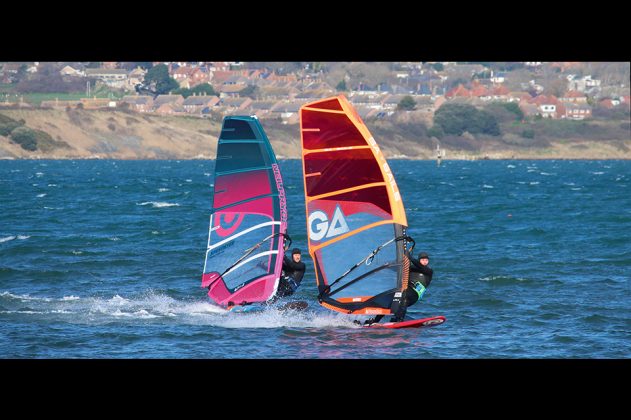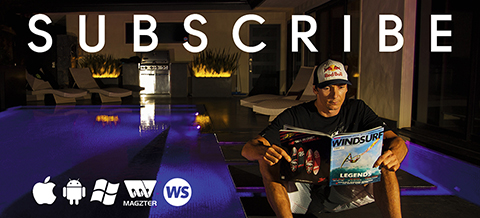WITH SPEED COMES EASE
6.5M NO-CAM FREERACE SAIL TEST 2018
Test Editor Tris Best // Second Testers Maurin Rottenwalter & Joe North
Photos Alex Best // Test location Portland Harbour
If you read the blurb for all the sails in this test by their respective brands, there is a consistency that can’t help but be noticed. Every contender, without exception, prescribes to the alchemy of providing the top end speed (akin to their race-oriented cambered counterparts) but with the ease and practicality of being camber-inducer free. And yet … is that really possible? If it were, why don’t the PWA slalom aficionados use no-cam sails on the tour? We sent our test team in, to delve deeper.
This test was originally published in the April 2018 issue.
The development that goes on at the fore of sail design never ceases to amaze. You think that the industry has reached an impressive threshold for performance and will surely plateau. They’ll reach a ceiling for innovation, as there is nowhere else they can go to next. And yet subtle strides forward continue, almost under the radar, until, in a few years time you look back at past iterations and can’t believe the progression that has been made. Top end race sails truly are works of art, seeming to defy physics and coping in conditions well beyond what was conceivable just a few years ago. But top end performance comes at a price. Fully cambered race sails aren’t the easiest to rig and often feel incredibly physical unless settled and fully powered, which accounts for all cornering, lulls and use in variable winds. Add to that the fact that windsurfing kit is about finding harmonies between the various components, so that they can fulfil that well used cliché of being greater than the sum of their parts. A fin and a board, a mast and a sail – they all have their ideal partners for the perfect setup. The same is true when you decide which sail to partner your board with (and vice versa). So if you want to play with the big boys (and girls) and get yourself a state of the art sail, you best ensure you have the minerals (and something left in the coffers!) to afford the latest slalom board (and fins) as well.
These no-cam freerace sails have come a long way in the recent past. Traditionally focussed purely on top end performance, their range of set and use has broadened immeasurably. And what is more, the developments that have occurred at the racing pinnacle have noticeably trickled down into this sail category. They offer a genuine taste of the racing thoroughbred sensation and give you a proper crack of the whip, but with a fraction of the rigging and handling hassle. They can partner a variety of boards, from the 150L intermediate progression hull right up to the snorting, fire-breathing slalom board.
Windsurfing, after all, is meant to be fun and these sails provide maximum blasting enjoyment for minimal emotional, physical… or financial commitment.
FINDINGS
‘Reduced luff curve’ is a concept now well-established amongst some brands, whilst others still tend to favour the more traditional method of using increased luff curve to ensure stability and structure. The difference in feel isn’t quite as clean cut though, as cunning methods are employed to give life and feel to sails with lots of luff curve (Dacron in the luff panels, stretch in the luff sleeve, not to mention a rock-steady and precise centre of effort), just as other techniques are used to counter any loss in stability when you reduce the tension in the leading edge. It’s all a question of feel, and the sort of feedback that best suits your style of riding. Ezzy, North Sails and Severne are the brands forging the way on reduced luff curves, whilst GA Sails, Goya and Loftsails favour the increased tension. The other brands slot somewhere between, with Neil Pryde unquestionably leaning towards the ‘reduced’ camp and Simmer leaning towards the other extreme.
This variety in luff curves goes hand in hand with the materials adopted in the layup. A freerace sail should feel alive in nature, inspiring the rider to lock into a committed stance and explore their limits. That said, in real world conditions, most riders need to come up for air! There needs to be some sort of escape route – a button that can be pressed that makes the sail (and the power it generates) more forgiving and practical. The sail needs to work around the rider without patronising them or detracting from the exhilaration of the ride. To this end, it’s noticeable amongst the group, just how many brands are opting for hybrid luff panels – panels that use a variety of materials to define the manner of the power delivery. Dacron, with its progressive delivery, is often used to varying degrees, combined with x-ply or monofilm, both of which favour the stretch-resistant more direct and immediate feel. Whether the split in materials is done longitudinally or vertically, well over half the brands here have chosen it as a method to determine the sail’s character. It demonstrates just how well thought out and modelled the modern sail is – the sweet spot of each sail calculated precisely and capable of being positioned accurately both in the horizontal and now the vertical plane.
SUMMARY
So onto the individual sails and we start with two that, without question, are right up there in the speed stakes. The Speedster from Neil Pryde and the AC-X from Point-7 are actually very similar in increments, outlines and characters. They are both incredibly slippery and efficient, the Pryde feeling a little more direct in the hands, whilst the Point-7 is a little softer, the delivery more subtle. If you’re looking for a sail to involve you rather than just being a passenger, then you should look to the Goya. Its power is stable and locked in; it’s just so punchy and engaging that it requires you to similarly commit. The Severne NCX goes to the other end of the scale, its super light feathery handling making its impressive performance range so accessible that it requires relatively little input from the rider. The Cheetah from Ezzy and E_Type from North would be best described as fast freeride sails. They both have masses of range and in the right hands can certainly keep up with the other sails here, but you do feel that you’re forcing the issue rather than the performance coming naturally. Which brings us to the all-rounders – GA Sails Matrix, Loftsails Oxygen and RRD’s Fire. Three very different feeling sails, but capable of being partnered with a variety of board and sailing styles. The GA relies on a broad centre of effort, the Loftsails on its natural range (backed up by tuning), whilst the RRD has plenty to give through tuning. Last but by no means least is the Simmer, the sail that surprised us the most. Setting with so much looseness in the upper panels it might look a little unique, but its combination of ease, feel and performance was breathtaking, making it a class act and popular with all who tried it.
THE LINE UP
• EZZY CHEETAH 6.5M



